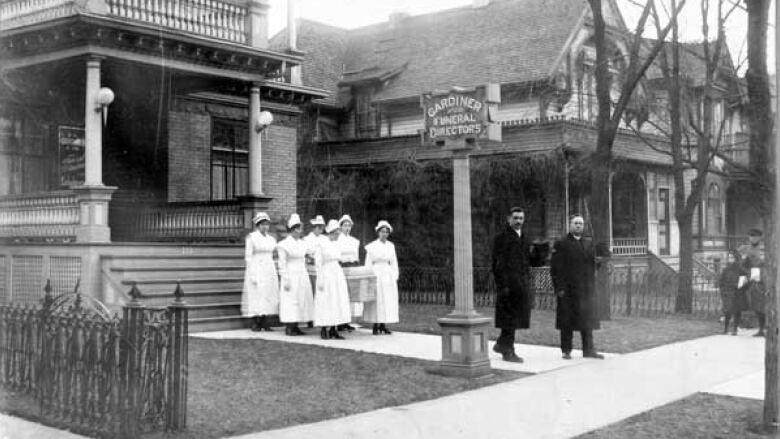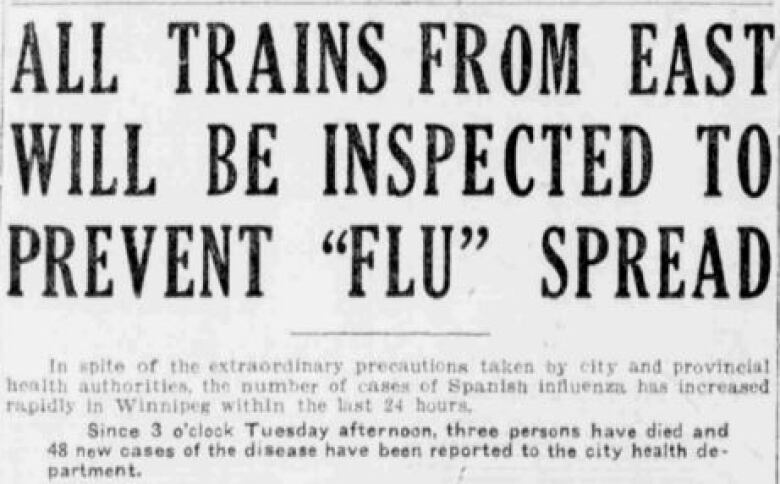Insurmountable chaos: How 2 soldiers stopping in Winnipeg helped lead to 1,200 deaths from Spanish Flu
October marks 100 years since the Spanish flu began to ravage Manitoba

On a fall day in Quebec in 1918, Pte. E. Murray and Pte. W. Barney got on a train heading west with a load of other soldiers, heading for battle in Siberia.
But Murray, Barneyand many others on the trainnever got there.
The soldiers soon started getting sick with aflu that started as aches and fever and then filled their lungs with fluid. When Murray, Barney and 21 others were dropped off in Winnipeg in the dying days of September, they brought the Spanish flu with them.
Within days,Murray and Barney died. They wereManitoba's first recorded deaths from the illness that triggeredthe most deadly world pandemic since the Black Death killed an estimated 50 million people in Europe in the 14th century.
"[Winnipeggers] knew that eventually the flu would come," said Christian Cassidy, a Winnipeg history blogger. "It wasn't a panic or anything. They kind of realized, 'We've been waiting for it, and now it's here.'"
In Canada, the flu killed at least 50,000 people, according to Parks Canada's website. Inadequate quarantine measures, lack of public health co-ordination and a medical "powerlessness" against it created what the site calls insurmountable chaos. Pushback afterward catalyzed the creation of the first federal department of health.
Looking back on the flu's path through Manitoba 100 years later, University of Manitoba history professor Esyllt Jones says it's difficult to grasp the extent of the illness today.
"If we imagine today having a disease outbreak that killed over a thousand people in the course of maybe three months, it would be terrifying to us," she said.
She's cautious to say there are "lessons" in the way Manitobans responded to it.
Society has changed, she says, yet she sees insights about how the pandemic played out across the province, from the mobilization of women to volunteer to gross inequalities in death rates based on race, as Indigenous communities dealt with death rates 10-times higher than the rest of the province.
"Disease outbreaks are an opportunity for divisions to become deeper," she said. "But they are also opportunities for ordinary people to help each other."
What was the Spanish flu?
To start with, Spanish influenza didn't look so different from your run-of-the-mill flu, Jones says. Aches and fever were common symptoms, and the fever was sometimes exceptionally high "high enough to cause delirium or, you know, mental health problems:depressions, suicidal thoughts, things like that."
The people who died from it would experience what Jones describesas something like the virus "turning their lungs into sponges."
"Their lungs would fill with fluid and they would asphyxiate, basically," she said. "Kind of a horrible death through a kind of cyanosis oxygen not reaching the blood because of the failure of the lungs to function."

Many deaths caused by the flu were a result of secondary infections that came as a consequenceof the disease, Jones says, notably bronchitis and pneumonia. The bacterial infections couldn't be treated in the pre-antibiotic period.
In his book The Last Plague, historian Mark Osborne Humphries notes that despite its name, the "Spanish flu" wasn't Spanish in origin. However, since Spain wasn't a combatant in the First World War and its press was uncensored, the country's media was the first to publish accounts of it in May of 1918, and the name "Spanish flu" caught on.
There is still some debate among researchers about where the flu originated, Humphries notes. But once it arrived in eastern Canada, he points to the Siberian Expeditionary Force's train as one of the notable vectors that spread it swiftly across the country.

Jones addsthat civilians travelling around might also have helped spread the disease: The first non-military death in Winnipeg was a woman who had just returned from a visit to family in Montreal.
As the disease spread, there wasn't much health-care providers could do other than provide basic supportive care: "Keep people hydrated, to ensure that they were, you know, getting some management for their fever, that they were receiving nourishment," she said.
"That was really the major problem with the disease outbreak that there was so little you could do for patients, and science just hasn't figured out why."
A city under strain
When Murray and Barney died in Winnipeg in the fall of 1918, the flu was in its second wave, Jones says. An earlier wavewith a lower death tollhad already run its course in spring before the more virulent strain reappeared. The city was unprepared.
"Nothing that we have ever experienced in the past anywhere approached this outbreak, both in the amazing rapidity of its spread and its virulence," reads a passage in the City of Winnipeg's annual health report for 1918.
"We were prepared in a measure for what to expect. The realization, however, far exceeded expectations."

At the time, the city was already under strain, Jones says, four years into a long and tiring war. Many families' breadwinners were overseasas were many physicians.
In that period, Winnipeg was the biggest city in the West, she adds. With a population just under 180,000, it was considered a metropolis.
"Winnipeg was a very diverse urban community in Canada at the time, having just gone through, before the outbreak of World War One, major immigration waves," Jones said.
"So there was still some tensions around ethnicity, as well as class, obviously because the Winnipeg General Strike erupted just around the time of the end of the second wave of the flu pandemic in spring of 1919."
There was some debate among health professionals and public health officials following the initial deaths about whether the sickness was even the Spanish flu, Jones says. Even today, flu can sometimes be difficult to diagnose, and the symptoms could simply look like a cold.
But as the death toll climbed into the hundreds over the next few weeks, public health measures began. Schools were closed, as were gathering places including churches and bars. Public gatherings were banned outright.
It didn't work. The disease reached its peak in mid-November, before dropping off. It re emerged, in a less significant way, in spring of 1919. But after that wave, the flu had largely run its course.
Death rate 10 times higher in Indigenous communities
Even as public health authorities work to maintain the social order, Jones says, disease has a way of highlighting the cracks in that order , such as social inequality.
In Winnipeg, where the flu killed roughly 1,200 people, working class and immigrant families tended to be more vulnerable, Jones said.
However, the most dramatic differential emerged between the death rates in Indigenous and non-Indigenous communities across the country. In Manitoba, recent research suggests the death rate in many Indigenous communities was 10-times higher than non-Indigenous ones.
Jones says the difference is in part a result of social and economic legacies of colonialism, as well as a lack of access to care experienced in many remote areas, although not all communities experienced the flu the same way.
"There are other examples of very serious devastation. And there are examples of, you know, people who managed because they were out on the trap line, managed to survive influenza because they weren't exposed to it," she said. "And you know, there's sort of things in between."
Jones says the pandemic fits into a long legacy of the relationship between colonialism and disease for Indigenous peoples in Canada.
"If we aren't cognizant of the impact of divisions in our society, there can be really negative repercussions when you have a disease outbreak. There can be scapegoating and stigmatizing, and there can be just gross inequalities in mortality," she said.
"If we want to understand the experience of Indigenous Canadians, we need to come to terms with the fact that, you know, their health inequality isn't something that's inevitable. It's a result of history."
Volunteer response
Central to the Canadian and Manitoban experience of the flu was the volunteer response, Jones says.
Public health infrastructure was just beginning to take shape in 1918, she says. There were no federal or provincial departments of health, and most of the heavy lifting was done by municipalities. The province had the legal right to establish a framework for measures such as quarantine, she says, but didn't actually administrate it themselves.
When the flu struck, health officials set up temporary beds, but they were understaffed partly because many physicians were overseas in the war effort.
In Winnipeg, at least 650 women volunteered to help the sick, bringing them food and caring for them. Women at the time had already mobilized to support the war effort, she says, and there's some overlap between flu volunteers and suffragists fighting for the right to vote.
"For whatever reason, in Winnipeg anyway, my own sense of this history is that there was a great deal of kindness between strangers," she said.
"That capacity that people have to act in a supportive way for one another, I think, is a big part of pandemic history and a big part of the history of flu."
Corrections
- An earlier version of this article incorrectly stated Pte. E. Murray and Pte. W. Barney died on Oct. 3, 1918. In fact, archival newspaper sources indicate they died on Oct. 6, while their tombstones indicate they died on Oct. 7.Oct 04, 2018 10:08 AM CT












_(720p).jpg)


 OFFICIAL HD MUSIC VIDEO.jpg)
.jpg)



























































































